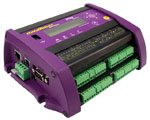AMAZON multi-meters discounts AMAZON oscilloscope discounts
Data loggers and data recorders are instruments that receive and record DC voltage, DC current, AC voltage, AC current, frequency, and charge. More generically, data loggers record measurements (temperature, relative humidity, light intensity, on/off, open/closed, voltage, pressure and events) over time. Sensor inputs include accelerometer, thermocouple, thermistor, RTD, strain gauge or bridge, pressure sensor, current loop transmitters, and LVDT or RVDT.
Data loggers and data recorders are often used to store data for subsequent downloads to a PC, but may also offer real-time features such as monitors and alarms. Data loggers (which are not necessarily data recorders) are often small, battery-powered devices that are equipped with a microprocessor, data storage and sensor. Most data loggers utilize turn-key software on a personal computer to initiate the logger and view the collected data.

above: 10 Color, 20 Input Hybrid Benchtop Recorder from Omega Engineering.
Important specifications to consider when shopping for data loggers and data recorders include:
- differential analog input channels: use the difference between two signals as an input; common mode is filtered out. Some systems offer differential inputs which are combinations of two single-ended inputs; here, twice the number of differential channels are available as compared to single-ended inputs.
- digital I/O channels: Digital or discrete channels are used for low-level (on-off) signals used in applications such as communication, user interface, or control.
- sampling frequency: frequency of the analog signal sampling and conversion to a digital value
- resolution: "granularity" of the digital word representing the analog value. A ten-bit number contains 210, or 1024, increments. A 0-10V signal could therefore be resolved into approximately 0.01V increments. A 12-bit representation would be in 212 (4096) increments, or divisions of 0.0024V for the same signal. Each additional bit doubles the resolution, and one bit is required for the polarity (sign) of a number.
- accuracy: depends on the signal conditioning linearity, hysteresis, temperature considerations, etc. Often noted as the percent full-scale of measurement range.
Other specifications to look for include:
- Type of application software used or needed
- memory and storage (example: the DT80, below, accepts a USB thumb drive)
- network specifications
- environmental parameters (ruggedness, water resistance, operating/ambient temperature and humidity requirements)
A smart protocol standard called 'SDI-12' exists that allows some instrumentation to be connected to a variety of data loggers. SDI-12 also support multi drop instruments.
Types of User Interfaces:
- no display
- front panel / display (example: see the image of the DT80 below)
- touch screens
- hand-held / remote programmers
- computer (PC) programmable
Host Connection types:
- Direct backplane interface
- RS232
- RS422
- ST485
- USB
- IEEE 1394
- GPIB
- SCSI
- TTL
- parallel
- Ethernet
- modem
- radio / telemetry
Typical Outputs:
- voltage
- current
- frequency
- timer or counter
- relay
- resistance or potentiometer
Data loggers and recorders may also be Web enabled, allowing programmability via a web browser.

above: dataTaker DT80 -- a modern, stand-alone data logger/data-acquisition system
Applications areas:
- general laboratory
- industrial
- environmental
- vehicle
- marine
- aerospace or military
- seismic or geological
- weather / meteorology
- medical / health
Data Loggers vs. pure Data Acquisition systems
A data logger is a data acquisition system, but a data acquisition system is not necessarily a data logger. This distinction has both pros and cons for data loggers.
Pros
Data loggers may be compact, portable and all-in-one units: Some data acquisition systems require the installation of a DAQ card in a PC. Wiring from sensors, transducers, thermocouples must also be brought over (and connected to) the PC. These systems work well in permanently-configured, on-line applications but may be expensive and difficult to implement otherwise. Data loggers significantly reduce the cost-per-channel for most logging applications and are significantly easier to implement. They can be placed in areas that bulky DAQ systems can not reach.
Cons
Data loggers typically have slower sample rates. E.g., a maximum sampling rate for a data logger may be 5 Hz -- this is considered very slow for full DAQ systems.
Links:
Wikipedia definition of Data Logger
PREVIOUS: Data Acquisition Hardware, part 2: PCI DAQ Boards | NEXT: Chart Recorders and Strip Chart